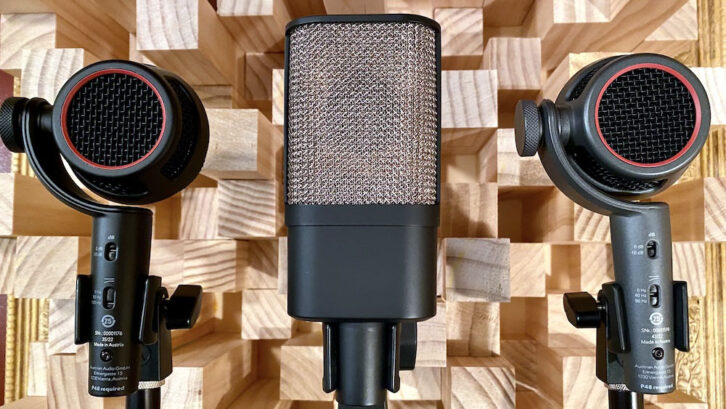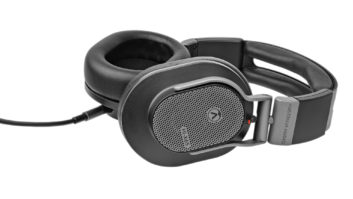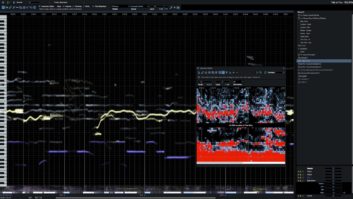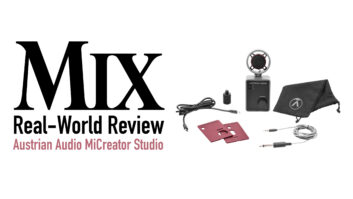
| MIX VERDICT: PRODUCTNAME |
| THE TAKEAWAY: “This trio from Austrian Audio fit my expectations and showed just how consistent the company’s line of microphones is.” |
| COMPANY: Austrian Audio • www.austrianaudio.com PRICE: OD5, $299; OC7, $519; OC16, $399 (all MAP) PROS: • Superb SPL handling. • Low noise. • Quality construction. • Mostly flat/neutral frequency response. • Versatile in application (especially the OC7). CONS: • OD5 can sound congested on acoustic guitar. |
In my previous reviews of Austrian Audio’s OC818 large-diaphragm condenser and CC8 small-diaphragm condenser, I noticed a few trends: high SPL handling, natural dynamic capture and frequency response much closer to “flat” than “colored.” In this review, I worked out the company’s new dynamic mic and two condensers, each with their own quirks, but largely following the trends previously identified.
OUT OF THE BOX
Much like the flagship OC818 (and similar, yet simpler, OC18), the OC16 is a large-diaphragm condenser with a “flask/cartridge”-shaped form factor, but only a cardioid pattern and a switchable, second-order high-pass filter at 40 or 160 Hz. The CKR6 capsule is like the 818 CKR12, but with a single diaphragm. SPL handling is 148 dB, with 20 Hz to 20 kHz response and 14 dB of self-noise. The OCS6 suspension mount, OCH8 clip and a soft-shell carrying case are included.
The OC7 is a small-diaphragm cardioid condenser with a “slim-body and swivel head” design for capturing instruments by allowing for convenient positioning with 220 degrees of head rotation. In addition to a second-order HPF at 40 or 80 Hz, the OC7 has a -10 dB pad. Frequency response is stated from 20 Hz – 20 kHz, with SPL handling at a whopping 154 dB and 19 dB of self-noise. The OCH8 clip and case are included.
The OD5 looks exactly like the OC7; it is an active-dynamic cardioid mic and requires phantom power, but provides a bit more output, helps encourage stability with long cable runs and allows an HPF. The filter here is a standard, moderately sloped, second-order type at 120 Hz, but also has a resonant filter at 80 Hz with a slight bass bump before sloping off at second-order. A -10 dB pad is switchable, with frequency response from 20 Hz – 18 kHz, SPL handling of 151 dB and 21 dB of self-noise. The OD5 ships with clip and case.
IN SESSION
I had the Austrian trio in my studio for a few months, and I put them up on every single session, knowing that I could trust them to perform, even in sometimes harried conditions—and perform they did, as I never found any inappropriate applications or encountered any overload or distortion. Particularly, I never once required the use of any of the mic’s pads; all SPL was handled even as I miked drums, loud guitar cabinets and percussion. When it comes to bulletproof, volume-munching capsules (and robust electronics), I’m not sure anybody can keep up with Austrian Audio.
Conversely, I sure did need the HPFs, as all three of these mics reach way down deep. The OC16 has plenty of extension and requires filtering for most anything but kick or floor tom, but the OD5 has that entirely different dynamic-mic-kind-of-bottom—it punches hard, and that’s not even counting the resonant HPF setting that gives you even more punch and a bit of thumpy hype.
The OC7 and 16 both have hot outputs, with the OD5 typically needing 25 percent more gain despite its active circuitry. None of the three seemed noisy, except for a tiny bit on the OD5 with lots of preamp gain on very quiet sources (i.e., finger-picked guitar).

I started out with trumpet and found the OD5 and OC16 made a nice pair, with ample but not harsh top-end from the 16 and some warm, comforting low-mids from the 5; with both equal in output level, no EQ was required other than HPF’ing in the mix.
The OC16 did a fine job on both drum overhead (mono, center position) and snare top (SPL was no problem with a medium-hard hitter), with an absence of harshness and no EQ required other than HPF’ing (in retrospect, I could’ve used the mics’ filters). The OD5 loves snare bottom, with nice chesty lows, no shrillness to the “snap” and a hotter output than my typical dynamic.
My usual pairing on close-miked electric guitar is an LDC and a Shure SM57, so I substituted the OC16 and the OD5 and got predictable results: no pads needed, complete frequency coverage, smooth articulation and a little high-mid mix EQ to create the tingly sizzle that the 57 usually provides.
Acoustic guitar found both the OC16 and the 7 getting me very nice sounds, with requisite detail, open dynamics and a lack of nastiness, up close to the neck or close to the bridge. I tried the OD5, too, but wasn’t feeling it, as it seemed a little congested and noisy for the delicate job.
SPL MTC Mk2 Monitor Controller – A Mix Real-World Review
Vocally, the OD5 will catch you off-guard, with a surprisingly nice chest mids-top balance that’s kind of like an E-V RE20 or Shure SM7B and sounds nice on loud rock singers (like many dynamics, it tames mouth noises and harshness). The two HPF filters make for nice options depending on your needs.
The OC16 seems slightly low-mid carved on male voice until you try the filters; 40 Hz balanced the bottom of the spectrum more smoothly, and 120 Hz made for a crisp and articulated modern vocal sound.
The real surprise, though, was the OC7, which sounds quite nice on male voice, with a very musical low-end translation, no mid-subtraction and a super-sweet top end. Sure, it’s a little sensitive to plosives, as SDCs tend to be, but if you use a good pop filter or go easy on the Ps, you’ll be okay with the mic’s 40 Hz filter.
TEST, CHECK, 1-2-3
Beyond actual session work, I did actually do some proper tests with all three transducers, which I’ll briefly summarize. All three handled the rigors of 16-inch floor tom without issue, but the OC7 had the only “no-EQ, perfect balance.” All three handled snare without overload or pad, although the OC7 had that elusive balance and detail that made rolling patterns ideal in balance and complexity.
All three struggled as I hit them with excessive vocal sibilance and plosives without a pop filter, but none were out of the ordinary or problematic in the slightest. In general, I have found all of Austrian Audio’s mics handle sibilance gracefully; maybe it’s the ceramic capsules or the membrane tensioning.
The ever-revealing test of tambourine was an eye-opener, and a reminder to never assume much with mic selection. The OD5 was delightfully punchy, with an ideal amount of zing and bite, maybe a little 2k-ringy, but this was a very useful tone. The OC7 was again supremely balanced if not quite as punchy. Unexpectedly, the OC16 seemed kind of toppy, with almost too much sizzle and a thin, lean bottom end that didn’t keep up with the others. Finally, I tried the most demand- ing test, piano, with curious results. The OD5 wasn’t a great choice here, but dynamic mics seldom are. The OC16 sure did capture the fullness, but seemed a little uneven through the mids, while also a bit cloudy on top-end detail. The top performer was the OC7, which grabbed transients beautifully, was just a tad shy of bottom end and had an openness up top that was quite beautiful. Classical pianist Alex Mauldin commented, “I can hear the airiness only with the OC7 and its much more lively sound.”
THE FINAL MIX
With superb quality construction, excellent fit/finish, wide frequency response, natural dynamic reproduction and fantastic high-volume handling, this trio from Austrian Audio fit my expectations and showed just how consistent the company’s line of microphones is. These folks know what they’re doing, and they’re doubling down on the above-mentioned qualities and traits for their entire line.
The OD5 has a classic dynamic mic sound, which is aided by active electronics, a swivel head, its high-pass filter and excellent SPL handling. I won’t hesitate to recommend it on drums, speaker cabs, loud vocals, horns and anywhere you would reach for a MD421/RE20/SM7B.
The OC16 is exceptionally priced and a suitable “starter mic” for those wanting an OC818 (or 18). The OC16 doesn’t quite have the linear mids, or pristine “truth,” of its siblings, but with careful use of its filters, it can be a fine vocal or instrument tool for those who don’t expressly need multiple patterns.
The OC7 is the darkhorse that I’ll now consider a frontrunner, with its inherent flat tonality (flat in a very good way), versatility of placement and wonderful SPL handling. For those who still record acoustic instruments (as well as vocals), I have to recommend a pair for stereo applications. I would imagine a pair of OC7s could handle just about anything in just about any stereo technique (excluding Blumlein and Mid-Side, obviously). They are a little pricey, but they earn every penny with their flexibility and quality.







